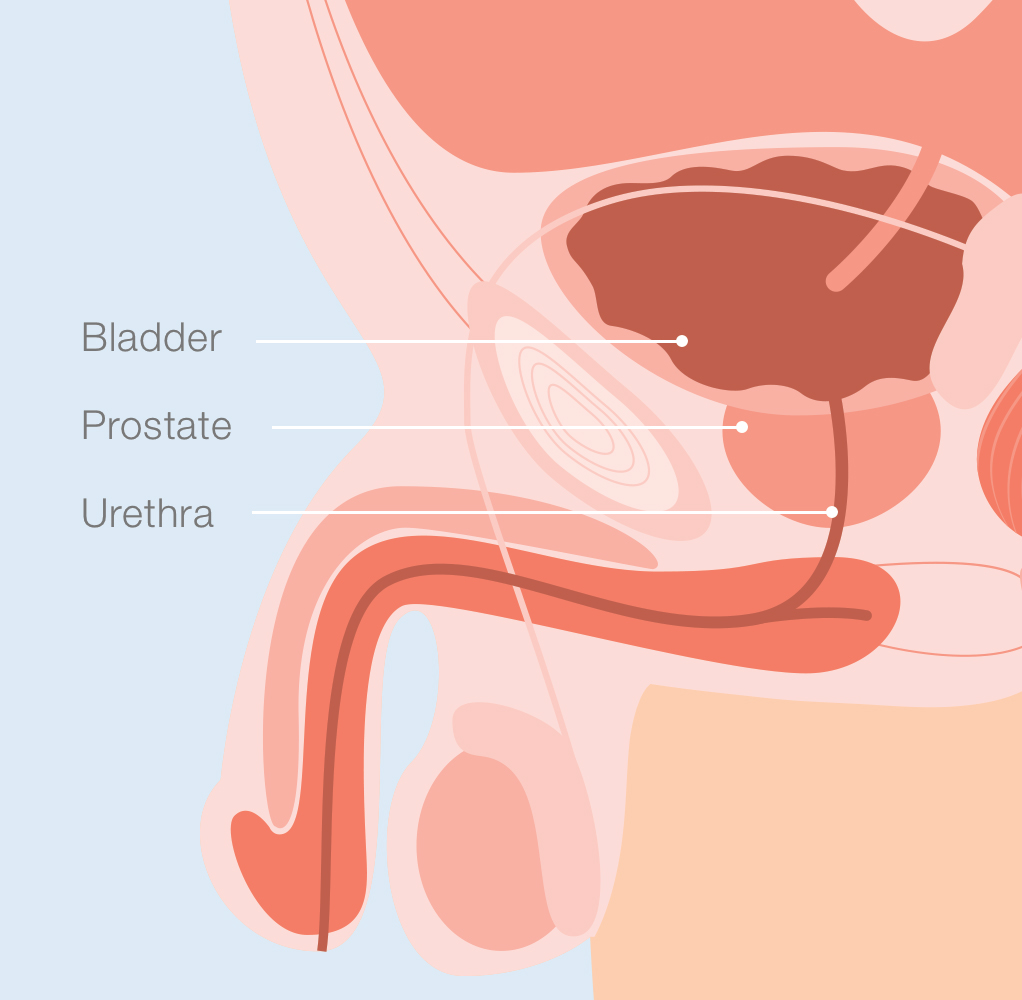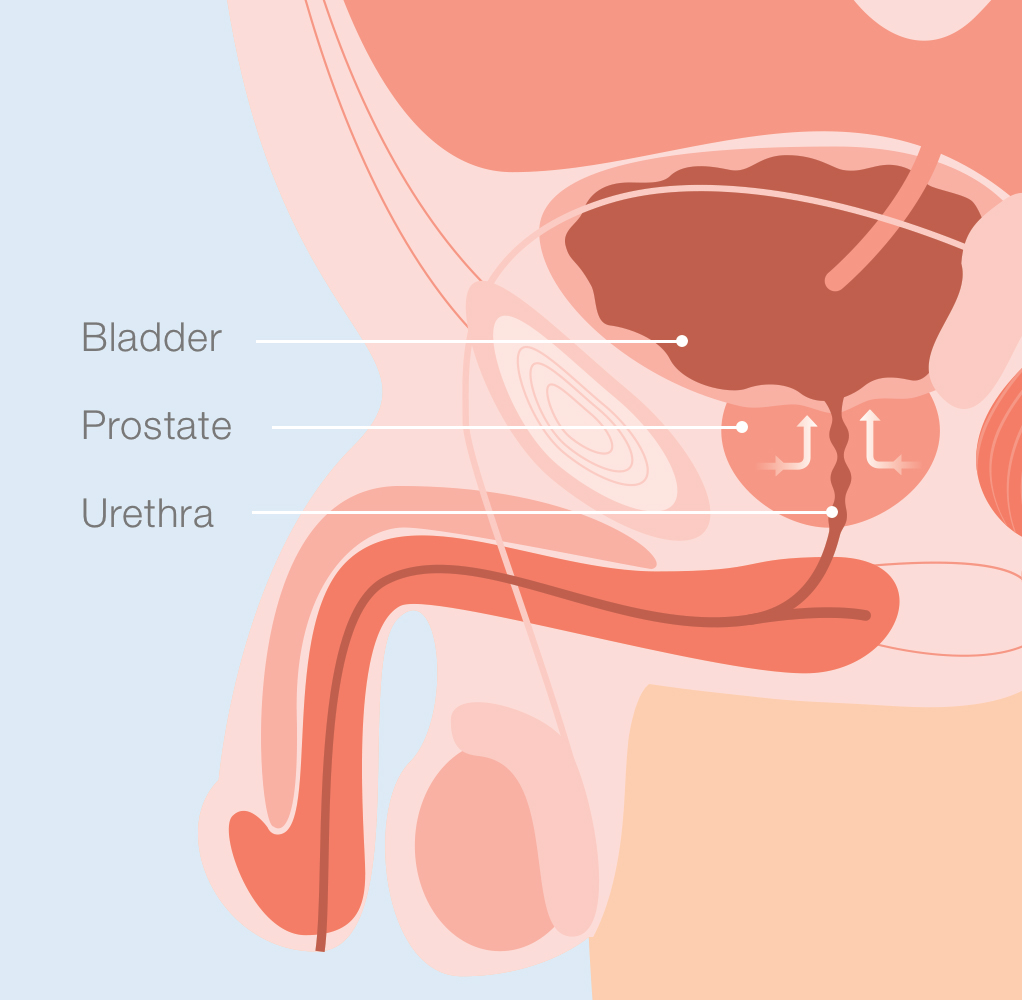Benign Prostatic Hyperplasia, or BPH, is more common than you think — 8 out of 10 men will develop BPH in their lifetime.1
The first step is talking to your doctor about what this condition means for you. Next, it's time to get the facts about BPH, including the technology and treatment options that will deliver relief and get you back to your everyday routine.
UNDERSTANDING BPH
Your Prostate and BPH

The prostate gland is situated below the bladder, surrounding part of the urethra, a thin tube that transports urine from the body. A normal prostate weighs about 20 grams and is the size of a walnut.

Your prostate naturally enlarges as you get older. In some men, as the prostate enlarges, it can put pressure on the urethra causing it to narrow, restricting the flow of urine and causing other adverse side effects.
BPH SYMPTOMS AND DIAGNOSIS
Difficulty starting to urinate
Sudden, recurrent urge to urinate
Dripping and leaking after urination
Interrupted, slow or weak urine stream
Frequent urination, especially at night
Painful, pushing or straining to urinate
Inability to empty your bladder completely
These symptoms may range in severity, and for some, the symptoms may impact day-to-day living. If you find yourself planning your errands around easy access to bathrooms, or BPH is impacting your daily routine, it may be time to talk to your doctor about an effective treatment plan.
If left untreated, BPH can lead to complications including urinary tract infections, urinary retention or even kidney failure. Talk to your doctor about which BPH treatment option is right for you.
Find a physician who specializes in BPH near you.
WONDERING ABOUT YOUR SYMPTOMS?
Take the BPH Quiz
This short quiz will assess your urinary symptoms and assign a score to your answers ranging from asymptomatic (0) to very symptomatic (41). Regardless of your score, if your symptoms are bothersome, you should consult with your doctor.
TAKE THE BPH QUIZIf you've been diagnosed with BPH, there are a wide variety of procedures to treat or remove the enlarged tissue from the prostate. Your doctor will help determine the right course of treatment based upon your symptoms.
Nonsurgical treatment options include:
This wait-and-see approach incorporates lifestyle changes that may provide BPH relief, including the establishment of regular bathroom visits, limiting evening fluids and decreasing alcohol and caffeine intake.
Daily medication can offer symptom relief, but does not cure BPH. Medical therapy for BPH attempts to shrink or stop the growth of the prostate. 1
Surgical treatment options include:
Prostate reshaping with iTind is a new in-office treatment for BPH patients seeking rapid symptom relief without permanent implants, painful heat-based therapies or daily prescription medications. Recovery is fast and patients are back to their normal lifestyle in no time. Learn more here.
TURP is a surgical procedure where the prostate is “shelled out” to gain space for normal urination and other BPH symptom relief. During the procedure, the prostate is reached by inserting a thin, tube-like instrument called a resectoscope through the urethra. A camera on the end of the resectoscope provides a magnified view of the prostate, and a loop at the tip of the resectoscope is passed along the prostate, removing the enlarged and obstructing tissue. TURP procedures are safe and have long-lasting results in treating BPH symptoms. TURP has traditionally been the “gold standard” in treatment for men with BPH.
An innovative and effective treatment for BPH is Plasma Vaporization Therapy. A device known as the PlasmaButton™ gently vaporizes the enlarged prostate tissue. Plasma Vaporization Therapy has shown a reduction in procedure time and catheterization time post-operatively while delivering long-lasting results and a quick return to normal activity. Learn more about Plasma Therapy.
High-powered lasers vaporize or ablate prostate tissue. A procedure consists of a laser fiber being passed into the urethra near the prostate using a Cystoscope where several bursts of energy are delivered through the laser fiber.1 The laser energy destroys prostate tissue and causes shrinkage. Laser surgery may not be as effective on larger prostates, and is typically appropriate for patients with small-to-medium sized prostates.
This device uses microwaves to heat and destroy excess prostate tissue. TUMT has not been reported to lead to erectile dysfunction or incontinence. Although microwave therapy does not cure BPH, it reduces urinary frequency, urgency, straining, and intermittent flow. It does not correct the problem of incomplete emptying of the bladder. The long-term effects of microwave therapy are still not clear. 1
A TUNA system delivers low-level radiofrequency energy through twin needles to burn away selected regions of the enlarged prostate. Shields protect the urethra from heat damage. The TUNA system improves urine flow and relieves symptoms with fewer side effects when compared with conventional surgery. No incontinence or impotence has been observed with this procedure. 1
The Plasma Patient
Plasma Therapy provides patients with shorter procedure times, a quick return to normal activities and long-lasting results. Find out if Olympus' Plasma technology is right for you.
Plasma Technology
The use of Plasma technology provides safe, long-lasting results for patients, while offering healthcare providers an easy-to-use solution.
Plasma Procedure
What to expect before, during and after surgery and the benefits of a Plasma Therapy procedure.
FAQs
Have questions about Plasma Therapy? Visit our FAQ page to get answers.






